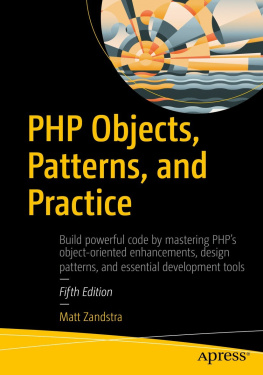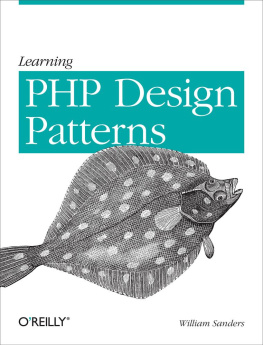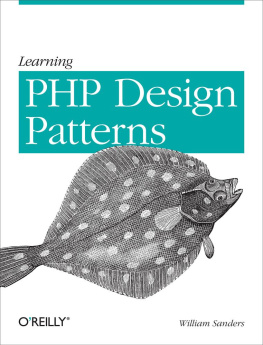In July 2004 PHP 5.0 was released. This version introduced a suite of radical enhancements. Perhaps first among these was radically improved support for object-oriented programming. This stimulated much interest in objects and design within the PHP community. In fact, this was an intensification of a process that began when version 4 first made object-oriented programming with PHP a serious reality.
In this chapter, I look at some of the needs that coding with objects can address. I very briefly summarize some aspects of the evolution of patterns and related practices.
I also outline the topics covered by this book.
The Problem
The problem is that PHP is just too easy. It tempts you to try out your ideas, and flatters you with good results. You write much of your code straight into your web pages, because PHP is designed to support that. You add utility functions (such as database access code) to files that can be included from page to page, and before you know it you have a working web application.
You are well on the road to ruin. You dont realize this, of course, because your site looks fantastic. It performs well, your clients are happy, and your users are spending money.
Trouble strikes when you go back to the code to begin a new phase. Now you have a larger team, some more users, a bigger budget. Yet, without warning, things begin to go wrong. Its as if your project has been poisoned.
Your new programmer is struggling to understand code that is second nature to you, although perhaps a little byzantine in its twists and turns. She is taking longer than you expected to reach full strength as a team member.
A simple change, estimated at a day, takes three days when you discover that you must update 20 or more web pages as a result.
One of your coders saves his version of a file over major changes you made to the same code some time earlier. The loss is not discovered for three days, by which time you have amended your own local copy. It takes a day to sort out the mess, holding up a third developer who was also working on the file.
Because of the applications popularity, you need to shift the code to a new server. The project has to be installed by hand, and you discover that file paths, database names, and passwords are hard-coded into many source files. You halt work during the move because you dont want to overwrite the configuration changes the migration requires. The estimated two hours becomes eight as it is revealed that someone did something clever involving the Apache module ModRewrite , and the application now requires this to operate properly.
You finally launch phase 2. All is well for a day and a half. The first bug report comes in as you are about to leave the office. The client phones minutes later to complain. Her report is similar to the first, but a little more scrutiny reveals that it is a different bug causing similar behavior. You remember the simple change back at the start of the phase that necessitated extensive modifications throughout the rest of the project.
You realize that not all of the required modifications are in place. This is either because they were omitted to start with or because the files in question were overwritten in merge collisions. You hurriedly make the modifications needed to fix the bugs. Youre in too much of a hurry to test the changes, but they are a simple matter of copy-and-paste, so what can go wrong?
The next morning you arrive at the office to find that a shopping basket module has been down all night. The last-minute changes you made omitted a leading quotation mark, rendering the code unusable. Of course, while you were asleep, potential customers in other time zones were wide awake and ready to spend money at your store. You fix the problem, mollify the client, and gather the team for another days firefighting.
This everyday tale of coding folk may seem a little over the top, but I have seen all these things happen over and over again. Many PHP projects start their life small and evolve into monsters.
Because the presentation layer also contains application logic, duplication creeps in early as database queries, authentication checks, form processing, and more are copied from page to page. Every time a change is required to one of these blocks of code, it must be made everywhere that the code is found, or bugs will surely follow.
Lack of documentation makes the code hard to read, and lack of testing allows obscure bugs to go undiscovered until deployment. The changing nature of a clients business often means that code evolves away from its original purpose until it is performing tasks for which it is fundamentally unsuited. Because such code has often evolved as a seething, intermingled lump, it is hard, if not impossible, to switch out and rewrite parts of it to suit the new purpose.
Now, none of this is bad news if you are a freelance PHP consultant. Assessing and fixing a system like this can fund expensive espresso drinks and DVD box sets for six months or more. More seriously, though, problems of this sort can mean the difference between a businesss success or failure.
PHP and Other Languages
PHPs phenomenal popularity meant that its boundaries were tested early and hard. As you will see in the next chapter, PHP started life as a set of macros for managing personal home pages. With the advent of PHP 3 and, to a greater extent, PHP 4, the language rapidly became the successful power behind large enterprise websites. In many ways, however, the legacy of PHPs beginnings carried through into script design and project management. In some quarters, PHP retained an unfair reputation as a hobbyist language, best suited for presentation tasks.
About this time (around the turn of the millennium), new ideas were gaining currency in other coding communities. An interest in object-oriented design galvanized the Java community. Since Java is an object-oriented language, you may think that this is a redundancy. Java provides a grain that is easier to work with than against, of course, but using classes and objects does not in itself determine a particular design approach.
The concept of the design pattern as a way of describing a problem, together with the essence of its solution, was first discussed in the 1970s. Perhaps aptly, the idea originated in the field of architecture, not computer science. By the early 1990s, object-oriented programmers were using the same technique to name and describe problems of software design. The seminal book on design patterns, Design Patterns: Elements of Reusable Object-Oriented Software (Addison-Wesley Professional, 1995) by Erich Gamma, Richard Helm, Ralph Johnson, and John Vlissides (henceforth referred to in this book by their affectionate nickname, the Gang of Four ), is still indispensable today. The patterns it contains are a required first step for anyone starting out in this field, which is why most of the patterns in this book are drawn from it.










